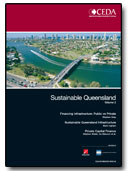The time may be right for Queensland to create more so-called "Public-Private Partnerships" (PPPs), using private sector finance, to fund infrastructure projects. To do so, they'll have to create attractive investment options to compete against stiff domestic and foreign competition for capital.
 Download the information paper
Download the information paper
Report highlights
Sustainable Queensland Volume 2 is the second of a three-volume series which reports on the challenges created by Queensland's rapid population growth. Volume 2 examines the options for financing and managing the state's new wave of infrastructure construction, expected to be worth more than $70 billion over the next decade.
Traditionally, the Queensland government has funded its own infrastructure development programs. Sustainable Queensland Volume 2 suggests the time may be right for Queensland to create more so-called "Public-Private Partnerships" (PPPs) using private sector finance. Globalised supply and demand for capital, and other resources, will require that Queensland agencies develop attractive enabling environments and transparent, efficient and competitive bidding processes.
Australia has large pools of private funds and private expertise to finance infrastructure. But the involvement of the private sector in infrastructure projects remains a controversial question. As Sustainable Queensland Volume 2 substantiates, there is no compelling case that government borrowing is always to be preferred due to its low cost of finance or that public-private partnerships (PPPs) should always be preferred due to the private sector's ability to access and structure financing arrangements. Perhaps the single most important key to the choice between private and public sector is to properly assess the infrastructure project's risks - using a whole-of-life approach - and assign the risks appropriately. The proposed benefits of PPP's relating to financing should be evaluated independently of benefits to other project phases (e.g. design, construction, operation) and evaluted on a case-by-case basis.
A review of studies of PPP's around the world indicates appropriately structured private participation, can:
- bring significant cost savings;
- let governments build infrastructure sooner;
- allow allocation of risk to the party best able to manage that risk;
- encourage innovation;
- provide access to the latest technology;
- improve customer focus; and
- promote economically sound decision-making.
There is enormous potential to achieve a "win-win" for both the Queensland public and private sector participants, providing the two groups understand and address each others needs.
CEDA's view
The first volume in the Sustainable Queensland series examined the demographic changes underpinning Queensland's growth, and the insatiable appetite of Queensland industry for skilled workers. It generated significant discussion and captured the interest of the media. Given the critical nature of the infrastructure issue, we expect an even greater response to this second volume. It tackles one of the most complex, controversial, yet fundamental enablers of Queensland's growth - the financing of infrastructure development. We look forward to both the public and private sector response.